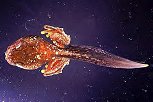Frog Glossary I

This is the tadpole of the rarely seen agalychnis craspedopus
Imidazole: An organic base
C3H4N2 ; a histamine
inhibitor, or an anti-histamine used to help fight off allergies.
Impacted: This is a condition that can potentially
kill your frog. It occurs when a piece of small gravel or other obstruction, is
(accidentally) swallowed by the frog
and then becomes a blockage in his intestinal tract. For
help with this malady, see
Impacted Intestines. Too much chitin can build up as a result of eating chitin rich exoskeleton shelled insects can also cause this.
Incandescent: An electric lamp in which a filament gives
off light when heated to incandescence by an electric current; called also incandescent,
incandescent bulb, incandescent light bulb, light bulb. (Quoted From 'Webster's dictionary)
Incidence: The number of new cases of a disease
occurring at a location in a defined period of time.
Indigenous: From that region or area. A native,
not an invader or introduced species.
Indirect sunlight, bright: In a Frogger's sense, a place where the vivarium or aquarium is placed that natural sunlight is within 5 feet of the area, but never directly touching the tank.
Infared: creates a radiated heat, and is invisible to human eyesight. Infared bulbs and ceramic heat emitters give off infared with little or no visible light.
 Infusoria: The miniscule, sometimes not seen by the human eye;
freshwater plankton species inhabiting ponds and calm streams. They can include daphnia, insect larval species, small crustaceans and even plant
species like algaes. Pictured to your right is an example of a magnified artemia, part of the freshwater plankton system.
Infusoria: The miniscule, sometimes not seen by the human eye;
freshwater plankton species inhabiting ponds and calm streams. They can include daphnia, insect larval species, small crustaceans and even plant
species like algaes. Pictured to your right is an example of a magnified artemia, part of the freshwater plankton system.
Intergrade: Offspring resulting from the breeding
of two sub-species.
Inpharzam: Inpharzam is used mainly in Germany and France, for treatment of
lower urinary tract infections, etc. See Diflucan as a substitution.
Ion Exchange resins:
Ion exchange resins are used in several industries, including the Aquarium/Fish trade.
They are used as a filter medium to remove metals and minerals from the water.
The little beads (that are charged) are coated with the replacement ions. In the case
of water softening the beads are coated with sodium and
Chlorine. Water flows over
the resin. The ions in the water are attracted to the resin. The ions in the water then
attach themselves to the resin, and knock off the ions that are already attached.
The resin is exhausted when all of the replacement ions are gone. In order to
regenerate the resin, a strong solution of the replenishment ions must be applied
to the resin. This removes the ions that came from the water and regenerates the
resin. The solution that is used to regenerate the ion beads is concentrated salt
water called brine.
Ivermectin: In the mid-1980's, ivermectin was
introduced as probably the
most broad-spectrum anti-parasite medication to this date. It is effective against most
common intestinal worms (except tapeworms). Available from your Vet,
print the info on Rhabdias
for him/her to understand treatment course you want to follow.

